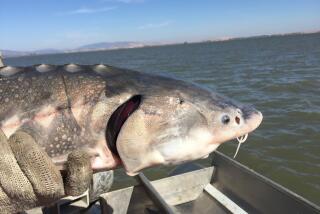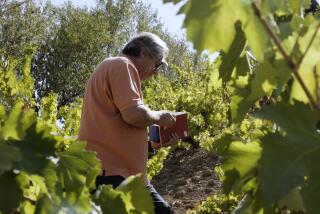Caspian Caviar Industry Struggles to Survive in Post-Soviet Era : Caucasus: Pollution, water levels and mismanagement reduce the sturgeon harvest.
- Share via
NEFTECHALA, Azerbaijan — Almost with a sigh, the rusting, World War II-era trawler slides up and docks against the crumbling cement quay of the fish-processing plant on the Kura River.
“God willing, this one will be good,” says Ilyas Panaliyev, director of the plant, which was once known throughout the Soviet Union for its fine caviar.
But Panaliyev’s tenuous smile dissolves into a frown as he speaks to the trawler’s captain. Instead of a hold bulging with beluga and sturgeon, there are merely a couple of carp flopping around in a wooden box, gulping for oxygen.
As the director of the largest caviar-processing plant in the newly independent nation of Azerbaijan, Panaliyev should be enjoying the perks that come with his position.
But the plant is on the verge of collapse, and the dream of huge profits from caviar sales on the world market has turned into a nightmare.
Around the entire Caspian, in fact, a combination of rising water levels and pollution from numerous sources has all but destroyed the caviar industry. This year’s sturgeon catch will be less than 1% of what it was 50 years ago.
Panaliyev shares with many managers of post-Soviet industrial plants a long, complex list of problems: lack of spare parts, lack of reinvestment capital, lack of motivation and productivity among underpaid workers and lack of experience in the international market.
But the main issue for him is the lack of fish in the Kura River, Azerbaijan’s traditional harvest area for both sturgeon and Caspian salmon.
Because of the inexplicable rise of Caspian waters, the silt carried by the Kura is forming a mud delta at the river’s mouth, making it difficult for larger fish to migrate upstream to spawn.
Hardest hit is the beluga sturgeon, whose eggs are the most prized of all. The beluga catch now represents only 1% of Azerbaijani caviar production. Locally, the fish may be nearing extinction.
“Ten years ago, we caught a beluga that weighed 500 kilos (1,100 pounds),” says a worker at Neftechala. “The fish was so big I had my picture taken with my legs dangling down the sides like I was riding a horse. It produced 100 kilos (220 pounds) in eggs.”
But those days are gone. The salty Caspian, the world’s largest lake and main source of caviar, has risen about 17 feet over the past decade.
Rising Caspian waters have devastated Neftechala’s caviar industry and slowly inundated homes and businesses. A showpiece sturgeon and salmon research institute and hatchery on the banks of the Kura hasn’t released a single minnow into the river for the past two years.
Pesticides used in upstream cotton fields are accumulating at an alarming rate at the river mouth. Nearby oil wells soon may be swamped, adding more pollutants to the fish-hatching beds.
The state of Azerbaijan’s petroleum industry is just as sad as that of caviar. Once a leading oil-producing region of the Soviet Union, Azerbaijan and the Caspian were thought to have been pumped almost dry.
But after Azerbaijan’s independence in 1991, Western oil companies declared the country to be a potential Kuwait if authorities could only exploit the vast wealth in a reasonable manner.
Seventy years of slapdash Soviet petroleum technology have left behind an ecological mess. Onshore, forests of rusting rigs continue to churn oil into leaky pipes running through densely populated neighborhoods, giving the drinking water a mild gasoline taste.
Leakage from offshore rigs has created dead zones in the fragile seabed. At the surreal, offshore oil “city” of Nefti Tashlar--”oily rocks”--a huge network of pipes, wells, storage tanks and eight-story barracks built on stilts seems ready to collapse.
Entire sections of pipe have disappeared, leaving wide, greasy, blue and yellow wakes down-water from abandoned rigs. The air is fouled by the blow-off of huge amounts of natural gas, both planned and unplanned.
All this intensifies Panaliyev’s worries about the slumping sturgeon harvest.
“We could solve this with a dredger in a day,” he said. ‘The problem is we don’t have a dredger, and the government won’t allocate any resources to rent one from the Russians, and we cannot get the money until we have dredged the river so there will be fish eggs to sell.”
Neftechala produced nearly 7 tons of sturgeon roe in 1992 and 8 tons in 1993. This year’s target is only 4 tons, but it’s doubtful the target will be met--both because of the lack of fish in the Kura and because the expensive roe is finding its own way to market.
One place where the missing caviar is appearing is the sleazy black-market center known as Kubinka in Baku, the Azerbaijani capital, where home-cured caviar sells for about $55 a pound.
Although twice last year’s price, this is a far cry from the $1,100 to $1,300 commanded by beluga eggs. The caviar sold in the back alleys of Kubinka may leave much to be desired, but the price is right.
At Neftechala, a patrol boat equipped with spotlights scours the night waters of the Kura River for sturgeon-poachers and checks weigh stations for the legal catch. All is quiet.
Later, awaiting dinner in the vessel’s cabin, crew members spin tales of life on the river, 200-pound masses of beluga eggs and platterfuls of mouth-watering sturgeon meat.
The cook serves them carp.
More to Read
Sign up for Essential California
The most important California stories and recommendations in your inbox every morning.
You may occasionally receive promotional content from the Los Angeles Times.












